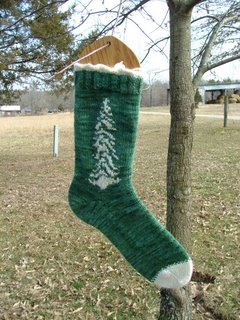
That's our old Sam dog on the right; the black spot where he seems to be looking is Shortstop, our (female) black lab. On the left in the background is the machine shed with large round bales of hay for the cows.
Then I cast on for another pair called Central Air, also from Blue Moon Fiber Arts. This was an extra pattern in the Rockin' Sock Club August '06 shipment, in case the main pattern, Titania's Revenge, required too much thinking.

I am using Fleece Artist Rose from The Loopy Ewe, and these are for the Princess, aka our College Girl. Instead of a standard heel, I decided these needed eye-of-partridge.

In case you're not familiar with eye-of-partridge, it's similar to your standard sl1, k1 heel stitch, but each right side row is offset by one stitch. In other words:
Row 1: *Sl1, k1, repeat from * across row.
Row 2: Sl1, purl remaining stitches across row.
Row 3: Sl1, k2, *sl1, k1, repeat from * across row, ending with a k (last repeat will be sl1, k2).
row 4: repeat row 2
If you lose your place and don't know whether you're on row 1 or row 3, do the first sl1, k1 and then look at the next stitch. If the stitch below the next loop is recessed from the surface, you need to slip it, and you are on row 1. If the stitch is raised from the surface, you need to knit it, and you are on row 3.
Almost forgot: eye-of-partridge draws up more than a standard heel stitch. How much? In order to do this scientifically, I made a standard heel out of the same yarn -- 32 stitches wide, 32 rows of heel stitch. It took 40 rows of eye-of-partridge to get to the same length. So if you're going to use this heel, plan on 25% more rows.















